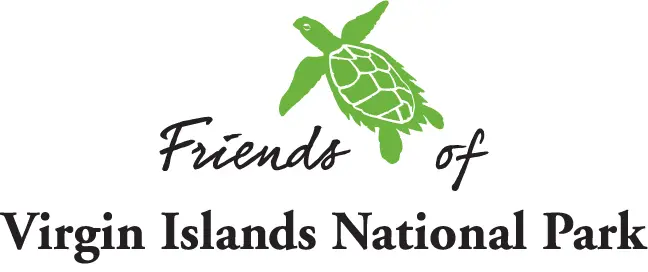Rare Leatherback Sea Turtle Nest Found on St. John
By Amy H. Roberts / Virgin Islands Source
When Leeanne and David DiGiacomo went for an early morning swim this Sunday on St. John, they were surprised to find what appeared to be tractor tracks emerging from the water.
“I’ve never seen sea turtle tracks,” said Leeanne, “but they looked just like a picture which I’d just seen on Facebook.”
In fact, they were the tracks of a female leatherback turtle making the first known nest on St. John in years. The last time a nest was found – in 2016 on Cinnamon Bay – it had already been poached.
By coincidence – or perhaps cosmic intervention? – several volunteers with the St. John sea turtle monitoring program all happened to arrive at the beach just then, and they knew just who to call.
They summoned Adren Anderson, co-director of the sea turtle program for the Friends of the Virgin Islands National Park. She’s tended to hundreds of nests of hawksbill turtles in the Caribbean and loggerheads in South Carolina, but she’d never seen a leatherback nest on St. John.
“I knew right away from the size of the tracks they were from a leatherback,” Anderson said. Leatherbacks are the largest of the seven species of sea turtles, often measuring nearly six feet in length and weighing up to 1,000 pounds.
“All turtles exhibit similar nesting behavior,” Anderson said, so she used her “turtle mama” intuition and soon found the nest; it was, however, in imminent danger of sea swell inundation, which meant she’d need to relocate the eggs to higher ground.
As Anderson dug a hole further up the beachscape to match the depth of the nest the leatherback had already dug, she was awed at the thought of the size of the flipper that could dig a hole more than two feet deep.
Then she carefully moved the 79 billiard-ball-sized eggs to the new hole along with the 35 “spacer eggs”– much smaller eggs that don’t contain embryos but allow more oxygen to circulate through the nest.
The relocated nest is now marked off and covered with a protective screen to keep predators, such as mongooses, from reaching the eggs as they incubate over the next two months.
Leatherback sea turtles are commonly seen nesting on St. Croix at Sandy Point National Wildlife Refuge on the westernmost tip of St. Croix.
“They like wide, sandy beaches which they can approach from deep water,” said Willow Melamet, who co-directs the program for the Friends of the VINP with Anderson. “Leatherbacks have soft, leathery shells, so they don’t like crossing over corals which can abrade their skin,” she said.
As of April 25 this year, 36 leatherback turtle nests have been counted at Sandy Point, as well as five green and eight hawksbill turtle nests.
St. John’s beaches are better suited to hawksbill turtles, which seem to favor secluded locations with nearby dense vegetation offering camouflage while nesting.
“Hawkbill turtles are small, agile, and tough enough to scurry up beaches and are not deterred by rocks,” said Melamet. Last season, the Friends’ sea turtle program documented 35 nests of the critically endangered hawksbill turtles on St. John and a nearby cay.
Now Melamet and Anderson are wondering if Sunday’s unusual leatherback nesting means there are more visits to look forward to. They’re working with Kelly Stewart at Sandy Point to use DNA samples to determine if the St. John leatherback is familiar to researchers on St. Croix. The leatherbacks on St. Croix are tagged when they come ashore to lay their eggs, and some are even tracked by satellite.
The nest on St. John is being closely monitored. It marks the official start of the turtle nesting season on St. John, which usually doesn’t get going until July, when the hawksbill turtles typically start coming ashore.
In anticipation, Melamet is hoping that boaters will take extra caution, knowing that turtles have to come up to the surface to breathe. Sea turtles spend their lives in the sea except when females come ashore to nest.
“Last year, we had seven green sea turtle strandings on St. John alone,” said Melamet. “Five of the turtles were definitely injured by boat strikes. Losing turtles that are near breeding age is a huge loss.”
Knowing the stakes, dozens of volunteers on St. John put in hundreds of hours to monitor the beaches of St. John for turtle nests.
“The odds of survival for a single sea turtle hatchling have always been slim, and it has been said that only one in a thousand hatchlings makes it to maturity,” said Melamet. “Now we’re saying one in five thousand.”
So why is a species that has been relatively unchanged for millions of years seeing such a rapid and extensive worldwide decline? “In one word, humans,” she continued. “Today, sea turtles face a plethora of potential fatal obstacles that hinder their ability to survive even after reaching subadult/adult size. Boat strikes, plastic ingestion, entanglement, disease, direct harvest, just to name a few.”
Anderson and Melamet have been trained to respond to turtle strandings with the Sea Turtle Assist and Rescue network, which provides rescue and stranding responses for sea turtles on all three islands.
“This past year, we have responded to over 20 stranding calls through the Sea Turtle Assistance and Rescue network,” said Melamet. “These calls have consisted of reports of entanglement, disease (fibropapillomatosis tumors), unusual behavior/floating, and boat strike injuries. Data in the form of a stranding report is collected, and if applicable, veterinary care and rehabilitation can be provided for live turtles at Coral World.” Call 340-690-0474 to report an injured turtle.
In June, the Friends of the VINP will begin training volunteers who wish to join the sea turtle monitoring program. Check their website for announcements, or call 340-779-4940.
For more information on the sea turtle program, visit the Friends website here.
